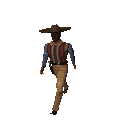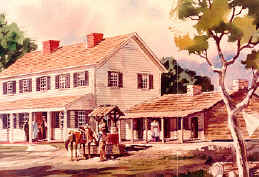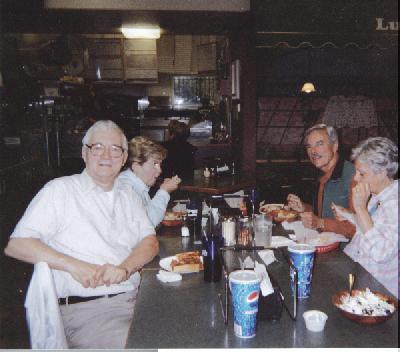
Hosted free by tripod.com


Fay's sister Gertrude, a teacher at the old Cottonwood School (north of the Baptist church, married the widowed father of two of her students. George Carter, of the Hayfork Carter-Duncan clan, had been married to Effie Robinson, and had two sons by her. Effie died, and Carter, a carpenter, brought his boys to Cottonwood when he found work here. And soon married Gertrude McNamar, his boys' schoolteacher (and daughter of the town newspaper editor). See the modern school
The house where the compiler/ author of this site has lived (since 1990) was built by George Carter and his two sons for their family in 1915. I had the pleasure not long ago of meeting George and Gertrude's daughter Roselle, who was five years old when her father and older brothers built this house (1915). She told about living out in a tent during that time, while the house was being built.
There were about three of four separate Carter families here in those years. J.E. Carter, who ran the garage in later years, is part of the (originally northern Trinity County) Carters who were so active in law and politics in Shasta County history.
Myrtle, incidentally, lived around the corner from this (the page-builder's) house where her husband's sister lived. (North-east corner of Parkway and Third). The site-compiler was told this by Ed Petersen.

To Pierson Barton Reading (pronounced Redding) belongs primary honor for the earliest American presence in the upper Sacramento Valley. In the last days of Old California, Viejo California, Reading assisted his mentor John Sutter in behalf of Gob. Micheltoreña in the latter's feuds with his rivals. Becoming a citizen of (Mexican) California, Reading joined the culture idealized by Richard Henry Dana in his early travelogue. Signing on as a sailor on a yankee trader, Dana, fresh out of harvard, challenged his mind by devoting himself to writing - giving us a picture of this land of Dons and caballeros ... and the mythical ZORRO.
Señor Reading was granted a vast grant stretching from Cottonwood Creek, 3 leagues in breadth along the west bank of the river, all the way to Salt Creek north of present day Redding. He was later made alcalde for the area.
When the Sonoma "Bear Flag" revolt took place in June 1846, Reading and the other Sacramento Valley grantees such as Sutter and Bidwell, who were all Mexican citizens, refused inititally to take part. Nevertheless, with their friend and ally Micheltoreña already driven out of California by his rivals, loyalty of the grantees soon shifted to "los Osos," the yankee rebels against the California government to the south.
In the spring of 1845, Reading discovered and named the Trinity River, plausibly but mistakenly surmising it emptied into Trinidad Bay.

Reading was involved in a large variety of projects and activities, ranging from politics, to steamship promotion, to laboring for peace between Indians and the flood of settlers that came in the wake of the Gold Rush. He had a flourishing ranch, planting orchards, raising livestock in the caballero tradition. By 1862 it was said Reading had the largest cattle ranch in all of California. Sad to say, some of the ranchos of southern California had met their demise through the rising discrimination of the Anglo period.
Reading helped negotiate the first treaty (1851) with local indigenous peoples, largely the Wintun speaking Nomo Lacke, and he kept that treaty, at one time defying a posse of angry whites bent on murdering his "Cottonwood Indians." The official USA representative signing that treaty was Major O. M. Wozencraft. Assisting him was Redick McKee, the genial yankee the Indians called Little White Father. He was clearly a man of Reading's stamp. Our local historian Rosena Giles ponders Reading`s effectiveness in his dealings with the Indians. She speculates, attributing it, beyond his basic honesty and integrity to: "his imposing apprearance, graciousness and dignity of manner, his native intelligence and diplomacy combined with courtesy." See source.
It is said that even when they held other whites (yapytoo) in suspicion and fear, local Indians (Nomo Lacke) revered Reading. They accorded him the title of respect "Shack-tu," and attended his funeral in large numbers, mourning after the Wintun manner the passing of so great a friend and chief.
I have found two main versions as to the origin of the word. One is that "Shasta" is taken from a Russian expression "Tchastal" referring to its white grandeur and magnificence. The other is that "Shasta" is taken from the name of the Indian tribe now known by the spelling "Shastan" or "Shastiki." The earliest reference Hazel McKim found to this version was a diary entry 14 Feb 1827 by Peter Skene Ogden of the Hudson Bay Company, who was acquainted with the tribe, and called the Mount "Sastine" in their honor.
One of the original counties when California became a state, Shasta County originally was "a vast principality stretching from the Oregon border on the north, to a line near present Red Bluff on the south, and from the Nevada border on the east, all the way to the Coast Range in the west." See source.

Disease was a factor; wanton murder which the white community did not view as murder at all; enslavement. But the principal cause was a more subtle and more dreadful thing, as C. Hart Merriam, a profound student of the California Indians, has pointed out; it was the gradual but relentless confiscation of their lands and homes, forcing them to seek refuge in remote and barren localities where health, even life itself frequently, could not be sustaiined. There was a cause even more subtle and dreadful yet --- a psychological depression resulting in the will to die, for their societies were slain.
John Collier discusses the legal travesty that occurred with regard to the California Indians:
Beginning in 1851, the United States negotiated treaties with 119 of the tribes. The Indians surrendered more than half of California (treaties were not negotiated with tribes occupying one-half of the state) and accepted, in return, perpetual ownership of [seven and one half million acres]. Through California pressure, the Senate in Washington denied confirmation of the treaties; the treaties and the record of the Senate's action were placed in the Senate's files, there to repose until 1905; the Indian Bureau, administrative guradian of the tribes, never breathe to the Indians what had transpired; the Indians remembered the treaties; they knew them by heart; they fulfilled their part of the supposed agreements only to witness the sale to whites, by the government, of every acre of the [seven and one half million acres] pledged to them.
Still another claim to fame
The Logan family was still another Cottonwood claim to fame. Known in those early days of Cottonwood and Tehama County as a racially mixed family, their accomplishments bear mention for their significance. The local patriarch of the clan was Pleasant Dixon Logan or "PD" as he was known. (The Logan name goes deep into Quaker roots of southeastern Pennsylvana and New Jersey. For example, Quaker ancestor James Logan invented the Conestoga wagon; was one of the first men of science in the American colonies; experimented on corn; was mayor of Philadelphia and Chief Justice of Pennsylvania Supreme Court.) Also retaining the Quaker faith of his Logan forefathers, PD Logan had been a friend and supporter of John Brown. About the time of Brown's execution in Virginia for his attempt to free the slaves (Harper's Ferry Raid), PD Logan came west (1859) to California, in large measure for the safety of his wife and son, who were of part African heritage. Mary Brown, widow of the abolitionist, came west with her son Salmon Brown in 1864, settling first in Red Bluff, then (1870) on to Humboldt County (Rohnerville).
The Logan family settled in Tehama County, later (1886) in Cottonwood. PD opened a harness and saddlery shop on Front Street, parallel to the railroad (location of Talbot Glass; then Wild West Trading Co, as of 2007; now in 2010 CL Collectibles). PD recognized that logging technique was hamstrung by awkward operations in getting their timber to the mills, and from the source in Shingletown to the railroad on the west of the Sacramento River.
Brooding on the problem, PD came up with the idea of a steam traction engine specific to improving the transport situation. Simple as it sounds now, at the time of PD's brainchild, just getting the logs to the river was a major challenge. He patented his invention and his son Alfred bought a lot on Front and Main Streets in Cottonwood where they constructed a factory to make the rigs at the site of present day Talbot Glass.
As Lita Claire Nueske explains, PD's invention rrepresented a huge "boon to the logging industry."
The traction engine hauled logs and lumber from the forests to the river, where the engine was placed on the ferry and moved across the Sacramento River to the west side to connect with the railroad.
R.R. Wise bought into the venture with PD Logan, and for five years they successfully built the engines. Then someone else saw the potential in the engines. Holt and Gregg, brick makers from Anderson, somehow became involved with the business and soon wrested the patent, machinery and equipment out of the hands of Logan and Wise.
Holt & Gregg first took the machinery to Anderson, then on to Stockton, California, where the engines became well known and accepted all over the west. Holt later used PD Logan's patent, among others, to start the Caterpillar Tractor Company.
Another local attraction is the Manton Apple Festival. No, Johnny Appleseed never made it to Manton, but with all the celebration of this life-giving fruit, he might as well have. Come in October (late September). It was pomologist Charlges Grandison Patten for whom the Patten Greening Apple was named. Monastery of Sain John
© Copyright 1998 - 2001 Robert Shepherd - All Rights Reserved

Dream Songs and Ceremony

Redding's thoroughly multicultural beginnings
Local Non-Profit and Public Service
![]()
Links, Locations, Resources, Services

Lord have mercy on a boy from down in the boondocks
site creator Bob Shepherd
last save 12.23.11